Related Research Articles

The 1924 United States presidential election was the 35th quadrennial presidential election, held on Tuesday, November 4, 1924. In a three-way contest, incumbent Republican President Calvin Coolidge won election to a full term. Coolidge was the second vice president to ascend to the presidency and then win a full term.
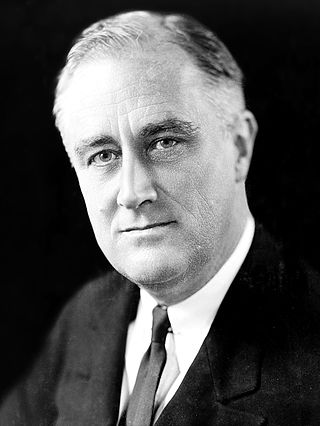
The 1932 United States presidential election was the 37th quadrennial presidential election, held on Tuesday, November 8, 1932. The election took place against the backdrop of the Great Depression. The incumbent Republican President Herbert Hoover was defeated in a landslide by Democrat Franklin D. Roosevelt, the governor of New York and the vice presidential nominee of the 1920 presidential election. Roosevelt was the first Democrat in 80 years to simultaneously win an outright majority of the electoral college and popular vote, a feat last accomplished by Franklin Pierce in 1852, as well as the first Democrat in 56 years to win a majority of the popular vote, which was last done by Samuel J. Tilden in 1876. Roosevelt was the last sitting governor to be elected president until Bill Clinton in 1992. Hoover became the first incumbent president to lose an election to another term since William Howard Taft in 1912, and the last to do so until Gerald Ford lost 44 years later. The election marked the effective end of the Fourth Party System, which had been dominated by Republicans. It was the first time since 1916 that a Democrat was elected president.

The Prohibition Party is a political party in the United States known for its historic opposition to the sale or consumption of alcoholic beverages and as an integral part of the temperance movement. It is the oldest existing third party in the United States and the third-longest active party.
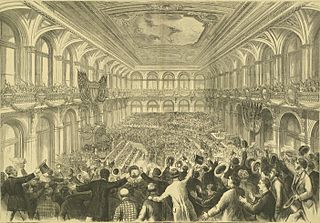
A United States presidential nominating convention is a political convention held every four years in the United States by most of the political parties who will be fielding nominees in the upcoming U.S. presidential election. The formal purpose of such a convention is to select the party's nominee for popular election as President, as well as to adopt a statement of party principles and goals known as the party platform and adopt the rules for the party's activities, including the presidential nominating process for the next election cycle.
In politics, a front-runner is a leader in an electoral race. While the front-runner in athletic events is generally clear, a political front-runner, particularly in the presidential primary process, is less so as a potential nominee may lead in the polls, have the most name recognition, the most funds raised, or a combination of these. The front-runner is most often declared by the media who are following the race and is written about in a different style than his or her challengers.
The 1948 Democratic National Convention was held at Philadelphia Convention Hall in Philadelphia, Pennsylvania, from July 12 to July 15, 1948, and resulted in the nominations of President Harry S. Truman for a full term and Senator Alben W. Barkley of Kentucky for vice president in the 1948 presidential election.

The 1924 Democratic National Convention, held at the Madison Square Garden in New York City from June 24 to July 9, 1924, was the longest continuously running convention in United States political history. It took a record 103 ballots to nominate a presidential candidate. It was the first major party national convention that saw the name of a woman, Lena Springs, placed in nomination for vice president. John W. Davis, a dark horse, eventually won the presidential nomination on the 103rd ballot, a compromise candidate following a protracted convention fight between distant front-runners William Gibbs McAdoo and Al Smith.
In United States politics and government, the term presidential nominee has two different meanings:
- A candidate for president of the United States who has been selected by the delegates of a political party at the party's national convention to be that party's official candidate for the presidency.
- A person nominated by a sitting U.S. president to an executive or judicial post, subject to the advice and consent of the Senate.
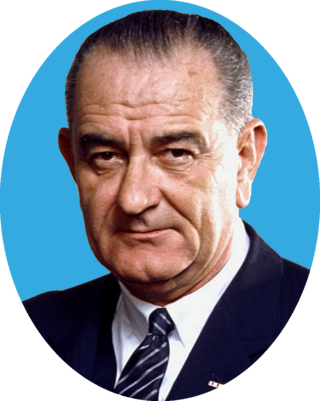
The 1964 Democratic National Convention of the Democratic Party, took place at Boardwalk Hall in Atlantic City, New Jersey, from August 24 to 27, 1964. President Lyndon B. Johnson was nominated for a full term. Senator Hubert H. Humphrey of Minnesota was nominated for vice president. The convention took place less than a year after President John F. Kennedy was assassinated in Dallas, Texas, and Kennedy's legacy was present throughout the convention.
The 1868 Democratic National Convention was held at the Tammany Hall headquarters building in New York City between July 4, and July 9, 1868. The first Democratic convention after the conclusion of the American Civil War, the convention was notable for the return of Democratic Party politicians from the Southern United States.

The 1960 Democratic National Convention was held in Los Angeles, California, on July 11–15, 1960. It nominated Senator John F. Kennedy of Massachusetts for president and Senate Majority Leader Lyndon B. Johnson of Texas for vice president.

The 1952 Democratic National Convention was held at the International Amphitheatre in Chicago, Illinois from July 21 to July 26, 1952, which was the same arena the Republicans had gathered in a few weeks earlier for their national convention from July 7 to July 11, 1952. Four major candidates sought the presidential nomination: U.S. Senator Estes Kefauver of Tennessee, Governor Adlai Stevenson II of Illinois, Senator Richard Russell of Georgia and Averell Harriman of New York.

The 1839 Whig National Convention was a presidential nominating convention held from December 4 to December 8 in Harrisburg, Pennsylvania. It was the first national convention ever held by the Whig Party, and was organized to select the party's nominee in the 1840 presidential election. The convention nominated former Senator William Henry Harrison of Ohio for president and former Senator John Tyler of Virginia for vice president.
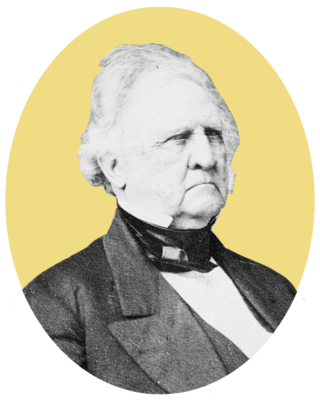
The 1852 Whig National Convention was a presidential nominating convention held from June 16 to June 21, in Baltimore, Maryland. It nominated the Whig Party's candidates for president and vice president in the 1852 election. The convention selected General-in-Chief Winfield Scott for president and U.S. secretary of the navy William A. Graham for vice president.
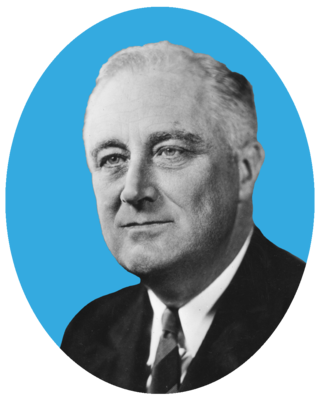
The 1940 Democratic National Convention was held at the Chicago Stadium in Chicago, Illinois from July 15 to July 18, 1940. The convention resulted in the nomination of President Franklin D. Roosevelt for an unprecedented third term. Secretary of Agriculture Henry A. Wallace from Iowa was nominated for vice president.

The 1932 Republican National Convention was held at Chicago Stadium in Chicago, Illinois, from June 14 to June 16, 1932. It nominated President Herbert Hoover and Vice President Charles Curtis for reelection.

The 1832 Democratic National Convention was held from May 21 to May 23, 1832, in Baltimore, Maryland. In the first presidential nominating convention ever held by the Democratic Party, incumbent President Andrew Jackson was nominated for a second term, while former Secretary of State Martin Van Buren was nominated for vice president.

From March 9 to June 1, 1948, voters of the Republican Party elected delegates to the 1948 Republican National Convention, in part to choose the party nominee for president in the 1948 United States presidential election.
The 1848 Democratic National Convention was a presidential nominating convention that met from Monday May 22 to Friday May 26 in Baltimore, Maryland. It was held to nominate the Democratic Party's candidates for President and Vice president in the 1848 election. The convention selected Senator Lewis Cass of Michigan for President and former Representative William O. Butler of Kentucky for Vice President.

From March 8 to May 20, 1932, voters and members of the Democratic Party elected delegates to the 1932 Democratic National Convention for the purpose of nominating a candidate for president in the 1932 United States presidential election. New York Governor Franklin D. Roosevelt was selected as the nominee through a series of primary elections and caucuses culminating in the 1932 Democratic National Convention held from June 27 to July 2, 1932, in Chicago, Illinois.
References
- 1 2 "How 'Favorite Son' Politics Works". The Pittsburgh Press . January 12, 1928 – via Google News Archive Search.
- 1 2 3 "No Demo Favorite Sons". The Deseret News . UPI. September 20, 1971. pp. 5A – via Google News Archive Search.
- 1 2 Meiklejohn, Don (July 3, 1960). "Favorite Son Idea is Devised to Put State in Strong Position at Convention". Ocala Star-Banner . Perry News Services. p. 22 – via Google News Archive Search.
- 1 2 3 "Smathers Gets Favorite Son Candidate Nod". Ocala Star-Banner. Associated Press. May 29, 1968. p. 1. Retrieved 2023-09-28– via Google News Archive Search.
- 1 2 Tucker, Ray (January 30, 1960). "How Term 'Favorite Son' Got Started in Politics". The Free Lance-Star. pp. 4, 7. Retrieved 2023-09-28– via Google News Archive Search.
- ↑ Shafer, Byron E. (1988). Bifurcated Politics: Evolution and Reform in the National Party Convention . Harvard University Press. p. 71. ISBN 9780674072565.
Favorite sons were already, almost necessarily, in decline as the nomination moved outside the convention in the prereform years.
- ↑ Tarr, Dave; Benenson, Bob (22 October 2013). Elections A to Z. CQ Press. ISBN 9781506331508 – via Google Books.
- ↑ "Favorite Son Groups Will be Numerous at 1940 Convention of Democrats". The Day (New London) . August 4, 1939 – via Google News Archive Search.
- ↑ But not only in them: in Lenin's will, Nikolai Bukharin was termed "the Party's favourite son": Randazzo, Francesco, Zarstvo and Communism: Italian Diplomacy in Russia in the Age of Soviet Communism. Cambridge Scholars Publishing, 2019, p. 110.